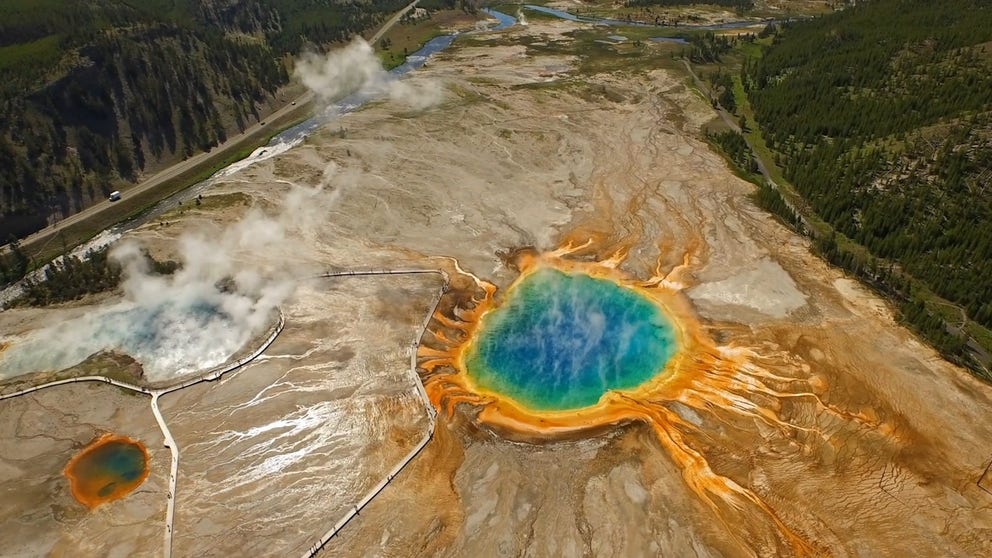Yellowstone National Park tests Starlink internet to improve earthquake, volcanic activity monitoring
Many of the GPS, seismometers, tiltmeters and temperature sensors used in and around Yellowstone National Park are located in remote areas, which means maintaining a strong connection can be challenging.
Yellowstone National Park
A look at the United States' first National Park: Yellowstone.
YELLOWSTONE NATIONAL PARK, Wyo. – The Yellowstone National Park volcano is closely monitored by dozens of instruments in and around the park. Recently, engineers began testing SpaceX Starlink internet to help gather volcanic and seismic data.
A magmatic eruption from the Yellowstone volcano hasn't occurred in more than 70,000 years, but it's the current site of one of the world's largest hydrothermal systems and largest geyser. Yellowstone National Park experiences between 1,500 and 2,500 small earthquakes a year, according to the Yellowstone Volcano Observatory (YVO).
To monitor this geologically fascinating region, many of the GPS, seismometers, tiltmeters and temperature sensors used in and around the park are located in remote areas to minimize the impact on the environment and visitors, which means maintaining a strong connection can be challenging, according to a blog post by Natalea Cohen, a graduate student at Michigan Technology University and EarthScope Consortium intern. The EarthScope Consortium is part of the YVO.
"Frequent visits to manually download data are just not possible – especially in the winter," Cohen writes.
STARLINK SATELLITES 'UNINTENDED' ELECTROMAGNETIC RADIATION COULD IMPACT RADIO ASTRONOMY OBSERVATIONS
Some visits to maintain monitoring stations happen by horseback to reduce the impact on sensitive areas, according to the YVO. For example, the Hayden Valley GPS station is five miles from a road and within a wilderness area.

A September 18, 2019 horse trek in Yellowstone National Park to GPS station in Hayden Valley complies with wilderness regulations, reduces impact to sensitive areas, and enables teams to upgrade equipment to keep the site operational year-round. (Image courtesy of Luke Morris/ Skyline Guest Ranch)
Radio and cellular communication options for monitoring stations both have downsides. Cell service can be slow during peak tourist seasons with visitor cellphone use. However, satellite-based communication is only dependent on access to the open sky.
Currently, SpaceX Starlink internet is being tested in Yellowstone to help decrease the use of cellular networks. The Starlink satellite constellation consists of more than 4,000 satellites orbiting Earth, beaming the internet anywhere with access to the sky and where a Starlink "dishy" is set up.
STARLINK INTERNET 'DISHY' FACES OFF AGAINST SNOW, WILDFIRES IN REMOTE CANADA
There are six borehole stations within Yellowstone National Park with instruments to monitor seismic and volcanic activity.

Borehole station B945, near Panther Meadow between Mammoth Hot Springs and Norris Geyser Basin in Yellowstone National Park. Left ("before") panel shows old VSAT satellite communication network, with a large, round antenna (Photo by Scott Johnson, EarthScope Consortium). On the right, a panel shows the station with a new Starlink antenna—the flat white square on top of the pole (Photo by Brendan Hodge, EarthScope Consortium)
In May, EarthScope Consortium engineers added a Starlink internet "dishy" to one of the borehole stations between Mammoth Hot Springs and Norris Geyser Basin. Initial tests show the connection is performing well. If that continues, engineers will add Starlink to more stations before the winter.
During the winter months, these stations will be hard to reach because of snow. Starlink internet has been shown to work in remote areas through extreme weather conditions, including Antarctica.
